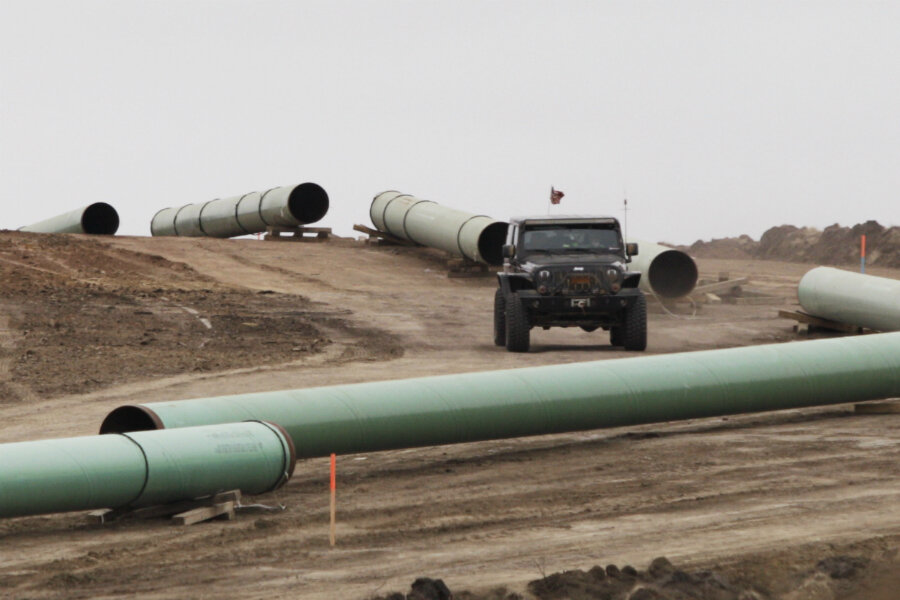Obama: Feds to consider re-routing Dakota pipeline to protect Native lands
Loading...
| Bismarck, N.D.
President Barack Obama has called for "peace" and "restraint" on the disputed Dakota Access oil pipeline, and says the U.S. Army Corps of Engineers is examining whether the four-state project can be rerouted in southern North Dakota to alleviate the concerns of American Indians.
Obama told the online news outlet NowThis that his administration is monitoring the situation closely but will "let it play out for several more weeks."
"As a general rule, my view is that there is a way for us to accommodate sacred lands of Native Americans, and I think that right now the Army Corps is examining whether there are ways to reroute this pipeline," Obama said in an interview Tuesday.
For the Native Americans who have gathered to oppose the pipeline's construction, the protest movement is part of a religious revival that touches on the region's indigenous history, as The Christian Science Monitor's Henry Gass reported from Cannon Ball, N.D.:
Indeed, talk to Native Americans here, no matter the tribe, and you will hear many of the same things. After generations of oppression and neglect, mired in systemic poverty and prevented from doing basic things like practicing their religion, the protesters here – who prefer to be called “water protectors” – see their stand against the Dakota Access Pipeline (DAPL) as not just a battle against a specific project, but public signs of a reconnection with their collective traditions and religion.
It is this reconnection, they believe, that has sustained the protest for over seven months. And in turn, it could have broader ripple effects both on and off tribal lands. For one thing, the protests here may be turning Native Americans into a leading force in the domestic movement on climate change.
Corps spokeswoman Eileen Williamson said Wednesday the agency had no immediate comment on the president's remarks. She said a statement by the agency was expected later in the day.
The White House said the Corps was exploring a range of options that would address concerns raised by tribal officials and others. Separately, the Army, the Justice Department and the Interior Department are discussing with tribal governments how to prevent future disputes with the federal government over public works projects, according to the White House.
Standing Rock Sioux Chairman Dave Archambault welcomed Obama's statement but said the administration and the Corps should go farther and stop work on the pipeline and do a full environmental impact study.
The 1,172-mile, $3.8 billion pipeline will carry oil from North Dakota through South Dakota and Iowa to a shipping point at Patoka, Illinois. It will skirt the Standing Rock Sioux Reservation that straddles the North Dakota-South Dakota border.
The tribe objects to the project, saying it could threaten drinking water and destroy sacred sites. The tribe has sued federal regulators for approving permits at more than 200 water crossings.
Protests that have included clashes with police and pipeline security also have gone on for several months in North Dakota, where hundreds and at times thousands of people have set up a large camp on corps land. More than 400 protesters have been arrested since August. No serious injuries have been reported.
Obama called it "a challenging situation."
"There's an obligation for protesters to be peaceful, and there's an obligation for authorities to show restraint," he said. "I want to make sure that as everybody is exercising their constitutional rights to be heard, that both sides are refraining from situations that might result in people being hurt."
The Dakota Access pipeline's capacity is about half of North Dakota's current production at present. The state, the No.2 oil producer behind Texas, this summer slipped below 1 million barrels daily for the first time in two years due to a slump in world oil prices.
About 350 miles pipeline would pass through North Dakota at a cost of about $1.4 billion, making it the longest leg of the project and its most expensive.
The pipeline's path in North Dakota would cross beneath the Little Missouri River once and the Missouri River twice, near Williston and at under Lake Oahe, a river reservoir, near the Standing Rock Sioux reservation. The company said the pipeline would include safeguards such as leak detection equipment. Workers monitoring the pipeline remotely in Texas could close block valves on the pipeline within three minutes if a breach is detected, the company said.
The federal government in September ordered a temporary halt to construction on corps land around and underneath Lake Oahe, a Missouri River reservoir in the Dakotas. The corps is reviewing its permitting of the project, but has given no timetable for a decision.
The company still needs federal permission to build the pipeline for about a mile stretch on either side of the reservoir and under it.
The corps also asked that the pipeline company voluntarily stop construction within 20 miles of Lake Oahe, but the company has ignored the request and continued construction.
Gov. Jack Dalrymple said Tuesday that construction on private land was slated to be completed by this weekend, leaving only the small section near the reservoir and under it remaining.
Associated Press writer Josh Lederman in Washington contributed to this report.







